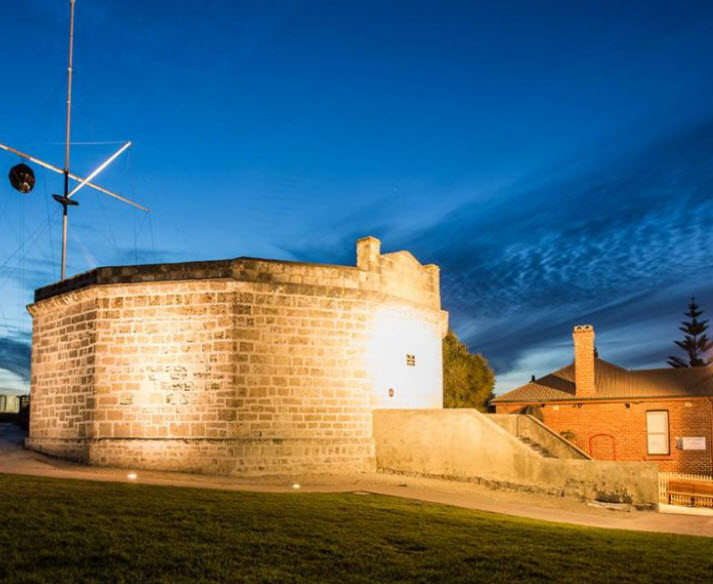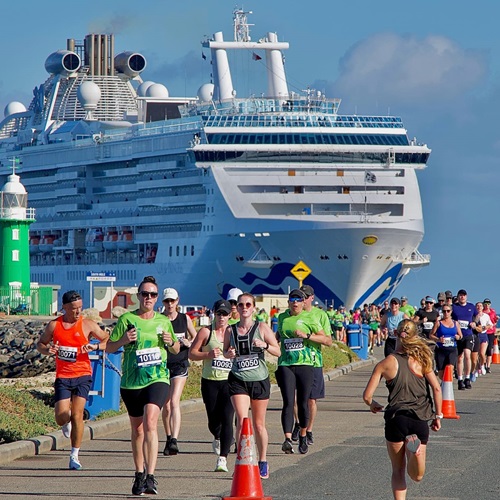Proudly supporting the Round House Cannon Firing Ceremony

The support is part of a new and exciting partnership between Fremantle Ports and the Fremantle Volunteer Heritage Guides Association (FVHGA), which provides daily tours and other tourism activities at the Round House.
The new partnership was celebrated today at the Round House and kicked off with Fremantle Ports' Deputy Harbour Master, Captain David Heppingstone firing the cannon at 1pm as the Honorary Gunner (below).

Neil Stanbury, of Fremantle Ports, said that supporting local history was very important to Fremantle Ports.
‘Having the opportunity to sponsor the cannon firing at the Round House to help celebrate Fremantle and its maritime history is really special.’
Robyn Littlewood, of Fremantle Volunteer Heritage Guides Association, said the Cannon Firing Ceremony was a highlight of many international visitor trips to Fremantle and was a great opportunity to share in Fremantle’s maritime history.
‘Fremantle Ports’ generous gift will allow the Guides to continue the Cannon Firing Ceremony,’ she said.
‘The sponsorship will allow some Guides to be specially trained to fire the cannon and will also pay for 12 months’ supply of maroons, which is the type of rocket used for the cannon firing.’

From left: Fremantle Councillor Rachel Pemberton, Ken Brown (Fremantle Volunteer Heritage Guides), Neil Stanbury (Fremantle Ports) and Captain David Heppingstone (Deputy Harbour Master, Fremantle Ports)
Throughout the year. the Cannon Firing Ceremony attracts requests from international students and visitors, school children and local community members to be Honorary Gunners.
Background information on the Round House and the cannon firing
The Round House is the oldest existing public building in Western Australia. Opened in January 1831, just 18 months after European settlement, it was built to hold people convicted of a crime and was used until 1886.
After it ceased being used as a jail, it became a police lock-up until the late 1890s and was then used as accommodation for the Water Police. After that it was used as a storage facility for Fremantle Ports.
After being threatened with demolition in the 1920s, the building was saved and control went to the State Government before it was deeded to the City of Fremantle.
The Cannon Firing Ceremony was taken over by the Fremantle Voluntary Heritage Guides in 1994.
Historically, the headland west of the Round House was an ideal site to send signals out to sea and over the years a variety of signalling systems were used. Early methods of signalling to ships off Fremantle were very simple. In 1846, regulations stated “… when Harbour Master makes signal from Gaol Hill, let go anchor …”.
A heliograph was also used for signalling between Fremantle and Rottnest Island.
A mirror was used to reflect sunlight and the coded message of long and short flashes (semaphore) could be seen over a considerable distance. This system was largely superseded by a telephone system in 1900.
From 1900, a time ball was used to signal the correct time for seafarers to set their chronometers (clocks used in/for navigation). A sliding ball was mounted on a pole extending from the roof of a small tower. The mechanism was connected by telephone line to Perth Observatory and when the clock struck one an impulse was sent down the telephone line to Fremantle, releasing the ball so that it slid down the pole. A gun was also fired. The time ball was moved from Arthur’s Head to the top of the new Fremantle Harbour Trust building in 1905. Time balls were superseded in 1937 by radio signals. The Signal Station was removed from west of the Round House to Cantonment Hill in 1929.

The time ball and flags at the Round House
The Fremantle Volunteer Heritage Guides (FVHG) fly Fremantle Ports’ flag proudly every day as recognition of the involvement the Round House has historically had with Fremantle Ports and the 1pm time ball and cannon.
Find out how you can explore the port or get ferry and cruise info...




.tmb-card500.jpg?Culture=en&sfvrsn=fdc20347_1)